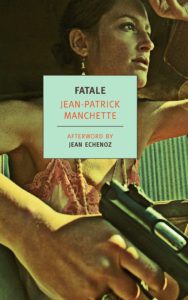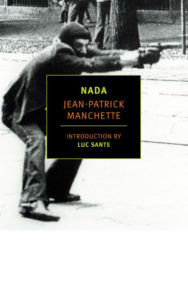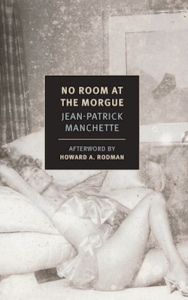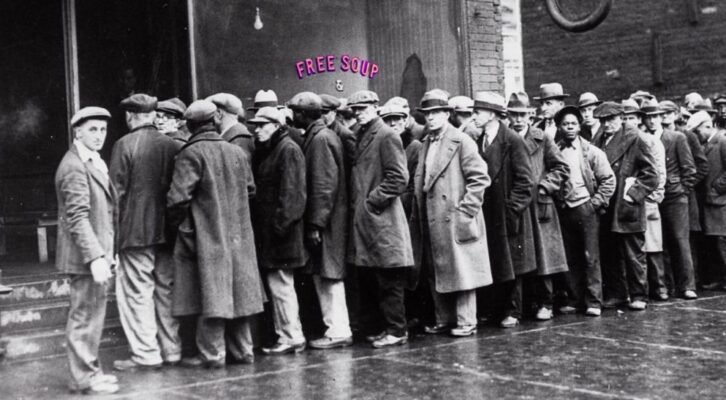Jean-Patrick Manchette (1942-1995) was a prolific French crime novelist, film and TV scriptwriter, translator, critic, and all-around laborer in Grub Street. His greatest achievement, almost certainly, was the cycle of ten or so dark social novels he produced in the 1970s the wake of (and much under the influence of) the May 1968 uprising in France. Here they are (the translations are by me except where otherwise indicated):
1971: Laissez bronzer les cadavres (Let the Corpses Tan). Written with Jean-Pierre Bastid. Untranslated.
1971: L’Affaire N’Gustro. Trans.: The N’Gustro Affair (New York: NYRB, in preparation).
1972: O dingos, O châteaux! Trans.: The Mad and the Bad (NYRB, 2014). Introduction by James Sallis.
1973: Nada. Trans.: Nada (NYRB, 2019). Introduction by Luc Sante.
1973: Morgue pleine. Trans. by Alyson Waters: No Room at the Morgue (NYRB, 2020). Afterword by Howard A. Rodman.
1976: Que d’os! (It’s Raining Bones!). Trans. by Alyson Waters (NYRB, in preparation).
1976: Le Petit Bleu de la Côte Ouest. Trans.: Three to Kill (San Francisco: City Lights, 2002).
1977: Fatale. Trans.: Fatale (NYRB, 2011). Afterword by Jean Echenoz.
1980: La Position du Tireur Couché. Trans. by James Brook: The Prone Gunman (San Francisco: City Lights, 2002).
1996: La Princesse du Sang. Trans.: Ivory Pearl (NYRB, 2018). Introduction by Doug Headline. Afterword by Gary Indiana.
Eight feature-length movies have been made from these books, not all of them very memorable—which is odd in view of Manchette’s close involvement with the French moviemaking milieu. Fantagraphics have published English-language comic versions of several of them.
The most recent of these novels to appear in English, in August 2020, is No Room at the Morgue, translated by Alyson Waters (New York Review Books). An excerpt was published by CrimeReads on August 24. The novel, from 1973, is one of just two in Manchette’s 1970s cycle to feature a series detective, namely Eugène Tarpon, a former policeman, now a private eye, haunted by guilt for having killed a demonstrator throwing stones; this was the closest Manchette came to mimicking the style and formula of the American hard-boiled subgenre, though it remained his main point of reference—and of reverence, for he was always in some way “in conversation” with it. Here is Manchette on his not uncomplicated relationship with the pre-WWII masters of pulp fiction:
“…to re-do the great Americans is to do something different from them…. What do you do when you re-do something at a distance—distant because the moment of that something is long gone? The American-style polar [roman policier] had its day. Writing in 1970 meant taking a new social reality into account, but it also meant acknowledging that the polar-form was finished because its time was finished: re-employing an obsolete form implies employing it referentially, honoring it by criticizing it, exaggerating it, distorting it from top to bottom.
Today Jean-Patrick Manchette is widely thought by the French not only to have transformed (and radicalized) the crime novel but also to have considerably blurred the dividing line between genre and properly “literary” fiction. Just recently, marking the twenty-fifth anniversary of his untimely death from cancer in 1995, the publication of a sturdy volume of his correspondence has unleashed a storm of new attention to his achievement.
In contrast, Manchette’s translation into English has been a slow process. Around 2000, considering how little French crime fiction was being translated into English, I tried to interest publishers in the idea of a series highlighting the new writing that had been going on in the genre in France. It was an idea, sadly, whose time had not yet come, and it died the death. In those days I was met with blank stares, or, if I was lucky, the answer that such an idea was a commercial nonstarter, and imported crime fiction in general a hopeless cause in the U.S. and U.K. markets.
Before 2000 you could almost count the French-language crime writers in English translation on the fingers of one hand: Simenon, of course—and for the longest time; Sébastien Japrisot; Boileau and Narcejac; and a couple of Daniel Daninckxes translated by Liz Heron, published in the 1990s by Serpent’s Tail in London and reprinted much later by Melville House in New York, one of them being Meurtres pour Mémoire (1984)/Murder in Memoriam, which played such an important part in the reawakening of the French to the massacre of Algerians by the Paris police in 1961. But who else? It was hard to say!
A few years later the phenomenal sales of Stieg Larsson’s trilogy precipitated the “Scandi-noir” moment, and today a plethora of publishers large and small are actively seeking crime fiction in English translation. Any list would have to include Europa, Little, Brown/Mulholland, Pegasus, Akashic, Quercus/MacLehose, Gallic, Bitter Lemon, Toby Press, Melville House, Penguin Random House, Serpent’s Tail, New York Review Books, and many, many others.
Even now, however, it is startling to realize just how much first-rate French crime writing remains untranslated. Consider how few of the following authors from a “wish list” of mine from 1999 have since made it—or made it in any significant way—into English: Bialot, Jonquet, Prudon, Ryck, Siniac, Vautrin, Bastid, Picouly, Dumal, A.D.G., Mosconi, Syregeol, Amila, Demure, Oppel, Pouy, Le Corré…. And that particular wish list was restricted to authors represented in the publisher Gallimard’s canonical Série Noire.
What did result from this otherwise fruitless endeavor of mine was that I began translating Manchette myself. Thanks to the contributions of Jim Brook and Alyson Waters, the entire cycle, as well as the much later, indeed posthumous Ivory Pearl, will soon have been done into English. We could not, perhaps, have chosen a more difficult author in the field, but of course, as the coiner (1979) of the label néo-polar (or, approximately, the neo-detective story) and the undisputed doyen of the gifted generation of chiefly left-wing authors often gathered under this rubric, he was an obvious first choice. But I myself had another, more subjective reason for my interest in Manchette. He and I were born within a few days of one another, albeit on opposite sides of the English Channel. And while I can hardly be accused of astrological tendencies, I confess that I have always felt an affinity for Manchette that was uncannily reinforced when I read his Journal 1966-1974 and found that we seemed to have been reading the same books and following parallel cultural and political paths. So I feel that Manchette is perfectly suited to my ideal goal as a translator: the successful “channeling” of one’s author—the ability, as it were, to get inside their head.
What Manchette did was politicize French crime writing, which had largely lapsed into a dusty and conservative proceduralism, while at the same challenging the formulas of the genre in many other ways. (In his extensive critical writing Manchette nevertheless expressed great admiration for many earlier practitioners of the genre, among them Léo Malet, Jean Amila, André Héléna, Francis Ryck, and Pierre Siniac.)
The socially critical dimension of Manchette’s work is at times explicit and at others strictly subtextual. As interested as he was in style, indeed in the French classical style, and in ways of alternately embracing and subverting its conventions, his enduring hope was that his literary activity would contribute materially to revolutionary change. He was a leftist of the anti-Stalinist variety. To understand this, it is helpful to consider the “anti-caper” novel Nada, from 1973, which recounts the ill-starred kidnapping of the American ambassador to France by a ragtag band of anarcho-communists. It is something of a prophetic cautionary tale, a warning to Manchette’s acquaintances on the far left that the temptation of terrorism was to be resisted at all costs. Years later, in 1994, addressing students at a technical high school, Manchette recalled his satisfaction upon learning that “some young extremists whom I did not know who were envisaging violent action had read Nada and treated it as a theoretical text and abandoned their plans.” Manchette noted, however, that “a novel can never be a pamphlet.”
Interestingly, he expressed reservations about Nada sixteen years after its publication. As Luc Sante notes in his introduction to the English translation (reprinted by CrimeReads on August 27 2019),“Manchette acknowledged that its political argument was ‘insufficient and obsolete,’ because it ‘isolated’ the gang from the broader oppositional social movement, and furthermore failed to account for the ‘direct manipulation’ to which the State would have subjected such a group.” The basis of this self-rebuke, voiced in 1988 in the preface to a Spanish translation of the novel, was quite simple: “The reader might well argue that if, in 1972, writing a novel on terrorism, I dealt with its indirect exploitation by the State and neglected its direct manipulation, this was because I could not have foreseen the great increase that such direct manipulation was going to see in the years to come. The fact is, however, that as early as 1969 the Milanese had been bombed [in a frame-up] by the Italian secret police. And I could have considered the host of comparable instances that history offers…. And the great defect of Nada is that it remained utterly silent on this issue.”
In 1982, apropos of the American hard-boiled novel, Manchette wrote that, though it understood organized crime, it
“…had a blind spot when it came to terrorism. This genre was prohibited by the era in which it flourished from overcoming this blindness. In its golden age it was fundamentally antifascist. But whereas it dealt readily with Nazi terrorism it systematically ignored the Stalinist variety…. Although its virtue resides in its critique of the criminal it omits to criticize … that incongruous alliance of the democratic left with the GPU which was supposed to embody the “good” side of a world officially divided into two camps.”
A key word here is “officially”: just like Nada‘s critique of revolutionary violence detached from any actual mass movement, the notion that the Cold War was a charade, that the two sides were not really opposed but merely presented as opposed, betokens Manchette’s endorsement of the theories of Guy Debord and the Situationist International. Think of Debord’s well known observation that the public and media ho-hum reaction to “the fall of the Wall” betrayed the fact that East and West were not two systems but just two variants of capitalism. Here as in so many ways, Manchette’s worldview was a Situationist one—and this marked him off from many of the other writers of the néo-polar stable.
It is true that the “politics” is far more understated in many novels in the 1970s cycle, although Manchette has many ways—including sudden shifts of register between colloquial and literary style and subtle or blatant quotation or misquotation—of telegraphing his contrarianism to the reader. The N’Gustro Business (1971) resembles Nada in that the political dimension is on full display. Untypically, half of the narrative here is written in the first person, and this from the point of view of a young fascist. (One thinks of a similar device used by Jim Thompson in The Killer Inside Me.) The storyline hews close to the abduction and killing of the Moroccan leader Mehdi Ben Barka by the French secret police and agents of King Hassan II in Paris in 1965. (My translation of this novel is forthcoming from NYRB in 2021.)
It is an all-too-common mistake to treat Manchette as the moving spirit of a putative “néo-polar” movement. In 1981 Manchette wrote: “I coined the word ‘néo-polar’ on the model of such terms as ‘neo-bread,’ ‘neo-wine,’ or even ‘neo-president,’ as used by radical criticism to denigrate various ersatz products that replace the worthy items of the same name that they replace.” This clearly echoes the Situationists’ contemptuous use of the term ‘neo-Dada.’ In his last interview, in 1991, Manchette elaborated on this: “The avenues opened by the ‘néo-polar‘ were gradually conquered either by littérateurs (Artists with a capital A) or else by Stalino-Trotskyite Gorbachevophiles.” With reference to the first kind of co-optation, it is tempting to evoke the narcissism of small differences, for Manchette’s entire inner conversation over the years turned on the (ultimately impossible) sabotaging of literary aestheticism (“le Beau“) in the process of seeking an “anti-style” that would enlist writing in the cause of revolution. Here is Jean Echenoz’s answer to the question whether Manchette’s style may be described as classical. His writing, says Echenoz,
“…so completely possesses the power to be classical that in the end it can even over-refine the style in a way that I would almost call hysterical in its rigor while at the same time insidiously subverting its very classicism itself. What I wonder is which way the process works. Does Manchette start out from a perfectly mastered form of writing that allows itself para-classical gambits, or does he proceed exactly the other way round? I don’t really know.”
Echenoz (like others) notes Manchette’s way of introducing willful infelicities into otherwise impeccably constructed sentences: “perfectly calculated and superadded gimpiness that borders on preciosity, but a self-mocking preciosity.” The translator, who is already confronted by the near-impossibility of conveying the very feeling of a classical French style, can only echo (even perhaps play up) the various shifts in register whereby Manchette provocatively interrupts the flow of his narration. These include collusive nods to the reader and the sudden intrusion of an authorial first-person voice. Nor must we overlook his frequent use of humor—”Molière updated by Marx,” as someone put it.
It is worth noting by the way that some of Manchette’s variations on others’ texts serves no purpose beyond that of paying homage. Consider the striking incipit of The Prone Gunman:
“It was winter, and it was dark. Coming down directly from the Arctic, a freezing wind rushed into the Irish Sea, swept through Liverpool, raced across the Cheshire plain (where the cats dropped their trembling ears at the sound of the roaring in the chimneys) and, passing through the lowered window, struck the eyes of the man in the little Bedford van.”
Then compare and contrast the opening of Chandler’s story “Red Wind”:
“There was a desert wind blowing that night. It was one of those hot dry Santa Anas that come down through the mountain passes and curl your hair and make your nerves jump and your skin itch.”
But perhaps I should have said mainly paying homage, because Manchette cannot resist changing the register here with his joke about Cheshire cats.
Around 1981 Manchette took a long hiatus from novel writing. “When I realized that I could no longer operate behind enemy lines with my romans noirs,” he would say later, “I gave them up.” Abandoning the increasingly difficult task of pressing his fiction into the service of a receding revolution, he spent the next decade on what he self-deprecatingly described as “industrial art” (i.e. the entertainment industry, or “the spectacle”).
By the nineties, however, Manchette had found a second wind which by rights should have carried him into a new great cycle of noir novels to be named “People in Bad Times.” Now working on a broader, “geopolitical” canvas, Manchette envisioned a sort of historical comédie humaine tracing the world of “generalized covert action” from the 1950s on and developing what he slyly called the “neo-thriller.” Inspiration came less from Hammett’s Red Harvest than from John Le Carré and, especially, from the works of Ross Thomas, four of which Manchette had just been translating. Guy Debord remained an éminence grise.
Very sadly, all that remains of this project is the unfinished novel La Princesse du Sang, presented by Manchette’s son Doug Headline and published posthumously in 1996. Many French critics consider this work, incomplete as it is, to be Manchette’s masterpiece. For the English translation I used the title Ivory Pearl, the nickname (Cockney rhyming slang for “girl”) given to the female protagonist by a platoon of English soldiers who take her as a young girl for their mascot as they advance on Berlin in 1945. The action takes place mainly in Cuba’s Sierra Maestra in the 1950s, but the story has a reticular global reach. I strongly recommend the excellent afterword which we were fortunate enough to have Gary Indiana provide for the NYRB edition. The book will not disappoint those who admire Manchette’s extraordinary female protagonists, nor will they have any difficulty recognizing the enduring Manchettian world sketched in the opening sentences, still redolent of the Hammett-Chandler tradition, sentences that may well serve as a fitting coda to these remarks:
“The black Oldsmobile was advancing cautiously over the sand of a beach. Balazs was at the wheel. On the back seat Maurer and Branko framed a seven-year-old girl wrapped up in a sleeping bag whom they had rendered comatose by means of a morphine shot. It was daybreak. With its sidelights out the car was a shadowy outline against the gray sand of the deserted beach. The faces of the three men looked pale, and their clothing was dark.”






















